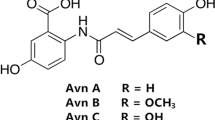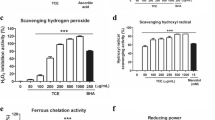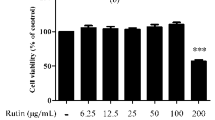Abstract
We evaluated the cytoprotective effects of americanin B, a lignan compound, against hydrogen peroxide (H2O2)-induced cell damage. Americanin B decreased the level of DPPH radicals, superoxide anions, hydroxyl radicals, and intracellular reactive oxygen species. Americanin B also attenuated DNA damage induced by H2O2 treatment, as shown by the inhibition of formation of comet tails, indicative of DNA strand breakage, and prevented the oxidation of protein and peroxidation of lipid, as determined by protein carbonyls and 8-isoprostane. Furthermore, americanin B protected against H2O2-induced apoptotic cell death, as determined by a reduction in the numbers of apoptotic bodies stained with Hoechst 33342. These findings suggest that americanin B protects cells against oxidative damage by exerting antioxidant effects and inhibiting apoptosis.






Similar content being viewed by others
References
Bandyopadhyay U, Das D, Banerjee RK (1999) Reactive oxygen species: oxidative damage and pathogenesis. Curr Sci 77:658–666
Beauchamp MC, Letendre E, Renier G (2002) Macrophage lipoprotein lipase expression is increased in patients with heterozygous familial hypercholesterolemia. J Lipid Res 43:215–222
Brand-Williams W, Cuvelier ME, Berset CLWT (1995) Use of a free radical method to evaluate antioxidant activity. Lebensm Wiss Technol 28:25–30
Cai YZ, Sun M, Xing J, Luo Q, Corke H (2006) Structure-radical scavenging activity relationships of phenolic compounds from traditional Chinese medicinal plants. Life Sci 78:2872–2888
Carmichael J, DeGraff WG, Gazdar AF, Minna JD, Mitchell JB (1987) Evaluation of a tetrazolium-based semiautomated colorimetric assay: assessment of chemosensitivity testing. Cancer Res 47:936–942
Cassidy A, Hanley B, Lamuela-Raventos RM (2000) Isoflavones, lignans and stilbenes—origins, metabolism and potential importance to human health. J Sci Food Agric 80:1044–1062
Chen JW, Zhu ZQ, Hu TX, Zhu DY (2002) Structure-activity relationship of natural flavonoids in hydroxyl radical-scavenging effects. Acta Pharmacol Sin 23:667–672
Cheng Z, Ren J, Li Y, Chang W, Chen Z (2003) Establishment of a quantitative structure-activity relationship model for evaluating and predicting the protective potentials of phenolic antioxidants on lipid peroxidation. J Pharm Sci 92:475–484
Choi HR, Choi JS, Han YN, Bae SJ, Chung HY (2002) Peroxynitrite scavenging activity of herb extracts. Phytother Res 16:364–367
Chung KT, Wong TY, Huang YW, Lin Y (1998) Tannins and human health: a review. Crit Rev Food Sci Nutr 38:421–464
Cunha WR, e Silva MLA, Sola RC, Veneziani SRA, Bastos JK (2012) Lignans: chemical and biological properties. In: Venketeshwer R (ed) Phytochemicals—a global perspective of their role in nutrition and health. In Tech, Rijeka, pp 213–234
Dixon RA (2004) Phytoestrogens. Annu Rev Plant Biol 55:225–261
Dmitriev LF, Titov VN (2010) Lipid peroxidation in relation to ageing and the role of endogenous aldehydes in diabetes and other age-related diseases. Ageing Res Rev 9:200–210
Farombi EO, Shrotriya S, Na HK, Kim SH, Surh YJ (2008) Curcumin attenuates dimethylnitrosamine-induced liver injury in rats through Nrf2-mediated induction of heme oxygenase-1. Food Chem Toxicol 46:1279–1287
Foti M, Ruberto G (2001) Kinetic solvent effects on phenolic antioxidants determined by spectroscopic measurements. J Agric Food Chem 49:342–348
Haraguchi H, Ishikawa H, Shirataki N, Fukuda A (1997) Antiperoxidative activity of neolignans from Magnolia obovata. J Pharm Pharmacol 49:209–212
Harper A, Kerr DJ, Gescher A, Chipman JK (1999) Antioxidant effects of isoflavonoids and lignans, and protection against DNA oxidation. Free Radic Res 31:149–160
Heim KE, Tagliaferro AR, Bobilya DJ (2002) Flavonoid antioxidants: chemistry, metabolism and structure-activity relationships. J Nutr Biochem 13:572–584
Hsu JY, Chu JJ, Chou MC, Chen YW (2013) Dioscorin pre-treatment protects A549 human airway eithelial cells from hydrogen peroxide-induced oxidative stress. Inflammation 2013:1–7
Kang KA, Zhang R, Piao MJ, Chae SW, Kim HS, Park JH, Jung KS, Hyun JW (2012) Baicalein inhibits oxidative stress-induced cellular damage via antioxidant effects. Toxicol Ind Health 28:412–421
Kim HS, Lee K, Kang KA, Lee NH, Hyun JW (2012) Phloroglucinol exerts protective effects against oxidative stress-induced cell damage in SH-SY5Y cells. J Pharmacol Sci 119:186–192
Kim KH, Choi JW, Ha SK, Kim SY, Lee KR (2010) Neolignans from Piper kadsura and their anti-neuroinflammatory activity. Bioorg Med Chem Lett 20:409–412
Kohno M, Mizuta Y, Kusai M, Masumizu T, Makino K (1994) Measurements of superoxide anion radical and superoxide anion scavenging activity by electron spin resonancespectroscopy coupled with DMPO spin trapping. Bull Chem Soc Jpn 67:1085–1090
Lee DY, Lee DG, Cho JG, Bang MH, Lyu HN, Lee YH, Kim SY, Baek NI (2009) Lignans from the fruits of the red pepper (Capsicum annuum L.) and their antioxidant effects. Arch Pharm Res 32:1345–1349
Lee DY, Seo KH, Jeong RH, Lee SM, Kim GS, Noh HJ, Kim GW, Kim JY, Baek NI (2012) Anti-inflammatory lignans from the fuits of Acanthopanax sessiliflorus. Molecules 18:41–49
Lee KM, Yun CH (2012) Potential in vitro protective effect of quercetin, catechin, caffeic acid and phytic acid against ethanol-induced oxidative stress in SK-Hep-1 cells. Biomol Ther 20:492–498
Lee WS, Baek YI, Kim JR, Cho KH, Sok DE, Jeong TS (2004) Antioxidant activities of a new lignan and a neolignan from Saururus chinensis. Bioorg Med Chem Lett 14:5623–5628
Li L, Abe Y, Kanagawa K, Usui N, Imai K, Mashino T, Mochizuki M, Miyata N (2004) Distinguishing the 5,5-dimethyl-1-pyrroline N-oxide (DMPO)-OH radical quenching effect from the hydroxyl radical scavenging effect in the ESR spin-trapping method. Anal Chim Acta 512:121–124
Li L, Abe Y, Mashino T, Mochizuki M, Miyata N (2003) Signal enhancement in ESR spin-trapping for hydroxyl radicals. Anal Sci 19:1083–1084
Lien EJ, Ren S, Bui HH, Wang R (1998) Quantitative structure-activity relationship analysis of phenolic antioxidants. Free Radic Biol Med 26:285–294
Maroto R, Perez-Polo JR (1997) BCL-2-related protein expression in apoptosis: oxidative stress versus serum deprivation in PC12 cells. J Neurochem 69:514–523
Mei RQ, Wang YH, Du GH, Liu GM, Zhang L, Cheng YX (2009) Antioxidant lignans from the fruits of Broussonetia papyrifera. J Nat Prod 72:621–625
Melidou M, Riganakos K, Galaris D (2005) Protection against nuclear DNA damage offered by flavonoids in cells exposed to hydrogen peroxide: the role of iron chelation. Free Radic Biol Med 39:1591–1600
Mena S, Ortega A, Estrela JM (2009) Oxidative stress in environmental-induced carcinogenesis. Mutat Res 674:36–44
Moss GP (2000) Nomenclature of lignans and neolignans (IUPAC Recommendations 2000). Pure Appl Chem 72:1493–1523
Nguyen CN, Kim HE, Lee SG (2013) Caffeoylserotonin protects human keratinocyte HaCaT cells against H2O2-induced oxidative stress and apoptosis through upregulation of HO-1 expression via activation of the PI3K/Akt/Nrf2 pathway. Phytother Res 17:1810–1818
Noroozi M, Angerson WJ, Lean ME (1998) Effects of flavonoids and vitamin C on oxidative DNA damage to human lymphocytes. Am J Clin Nutr 67:1210–1218
Okimoto Y, Watanabe A, Niki E, Yamashita T, Noguchi N (2000) A novel fluorescent probe diphenyl-1-pyrenylphosphine to follow lipid peroxidation in cell membranes. FEBS Lett 474:137–140
Payá M, Halliwell B, Hoult JRS (1992) Interactions of a series of coumarins with reactive oxygen species: scavenging of superoxide, hypochlorous acid and hydroxyl radicals. Biochem Pharmacol 44:205–214
Pirinccioglu AG, Gökalp D, Pirinccioglu M, Kizil G, Kizil M (2010) Malondialdehyde (MDA) and protein carbonyl (PCO) levels as biomarkers of oxidative stress in subjects with familial hypercholesterolemia. Clin Biochem 43:1220–1224
Rajagopalan R, Ranjan S, Nair CK (2003) Effect of vinblastine sulfate on gamma-radiation-induced DNA single-strand breaks in murine tissues. Mutat Res 536:15–25
Rice-Evans CA, Miller NJ, Paganga G (1996) Structure-antioxidant activity relationships of flavonoids and phenolic acids. Free Radic Biol Med 20:933–956
Rosenkranz AR, Schmaldienst S, Stuhlmeier KM, Chen W, Knapp W, Zlabinger GJ (1992) A microplate assay for the detection of oxidative products using 2′,7′-dichlorofluorescin-diacetate. J Immunol Methods 156:39–45
Schühly W, Khan SI, Fischer NH (2009) Neolignans from North American Magnolia species with cyclooxygenase 2 inhibitory activity. Inflammopharmacology 17:106–110
Sharma P, Jha AB, Dubey RS, Pessarakli M (2012) Reactive oxygen species, oxidative damage, and antioxidative defense mechanism in plants under stressful conditions. J Bot 2012:217037
Singh NP (2000) Microgels for estimation of DNA strand breaks. DNA protein crosslinks and apoptosis. Mutat Res 455:111–127
Sinha K, Das J, Pal PB, Sil PC (2013) Oxidative stress: the mitochondria-dependent and mitochondria-independent pathways of apoptosis. Arch Toxicol 87:1157–1180
Tapiero H, Tew KD, Ba N, Mathé G (2002) Polyphenols: do they play a role in the prevention of human pathologies? Biomed Pharmacother 56:200–207
Terashvili M, Sarkar P, Nostrand MV, Falck JR, Harder DR (2012) The protective effect of astrocyte-derived 14,15-epoxyeicosatrienoic acid on hydrogen peroxide-induced cell injury in astrocyte-dopaminergic neuronal cell line co-culture. Neuroscience 223:68–76
Tezel G (2006) Oxidative stress in glaucomatous neurodegeneration: mechanisms and consequences. Prog Retin Eye Res 25:490–513
Tyrakowska B, Soffers AEMF, Szymusiak H, Boeren S, Boersma MG, Lemanska K, Vervoort J, Rietjens IMCM (1999) TEAC antioxidant activity of 4-hydroxybenzoates. Free Radic Biol Med 27:1427–1436
Ueno I, Kohno M, Yoshihira K, Hirono I (1984) Quantitative determination of the superoxide radicals in the xanthine oxidase reaction by measurement of the electron spin resonance signal of the superoxide radical spin adduct of 5,5-dimethyl-1-pyrroline-1-oxide. J Pharmacobio-dyn 7:563–569
Valentão P, Fernandes E, Carvalho F, Andrade PB, Seabra RM, Bastos ML (2002) Antioxidative properties of cardoon (Cynara cardunculus L.) infusion against superoxide radical, hydroxyl radical and hypochlorous acid. J Agric Food Chem 50:4989–4993
Valentão P, Fernandes E, Carvalho F, Andrade PB, Seabra RM, Bastos ML (2003) Hydroxyl radical and hypochlorous acid scavenging activity of small centaury (Centaurium erythraea) infusion. A comparative study with green tea (Camellia sinensis). Phytomedicine 10:517–522
Valko M, Leibfritz D, Moncol J, Cronin MT, Mazur M, Telser J (2007) Free radicals and antioxidants in normal physiological functions and human disease. Int J Biochem Cell Biol 39:44–84
Wang LY, Unehara N, Kitanaka S (2005) Lignans from the roots of Wikstroemia indica and their DPPH radical scavenging and nitric oxide inhibitory activities. Chem Pharm Bull 53:1348–1351
Yang CS, Landau JM, Huang MT, Newmark HL (2001) Inhibition of carcinogenesis by dietary polyphenolic compounds. Annu Rev Nutr 21:381–406
Yu JG, Li TM, Sun L, Luo XZ, Ding W, Li DY (2001) Studies on chemical constituents of the seeds from Atrabotrys hexapetalus (Annonaceae). Acta Pharmaceutical Sin 36:281–286
Acknowledgments
This research was financially supported by the Ministry of Trade, Industry and Energy (MOTIE) and the Korea Institute for Advancement of Technology (KIAT) through the Promoting Regional Specialized Industry.
Author information
Authors and Affiliations
Corresponding author
Additional information
Editor: T. Okamoto
Rights and permissions
About this article
Cite this article
Zheng, J., Piao, M.J., Kim, K.C. et al. Americanin B protects cultured human keratinocytes against oxidative stress by exerting antioxidant effects. In Vitro Cell.Dev.Biol.-Animal 50, 766–777 (2014). https://doi.org/10.1007/s11626-014-9759-9
Received:
Accepted:
Published:
Issue Date:
DOI: https://doi.org/10.1007/s11626-014-9759-9




